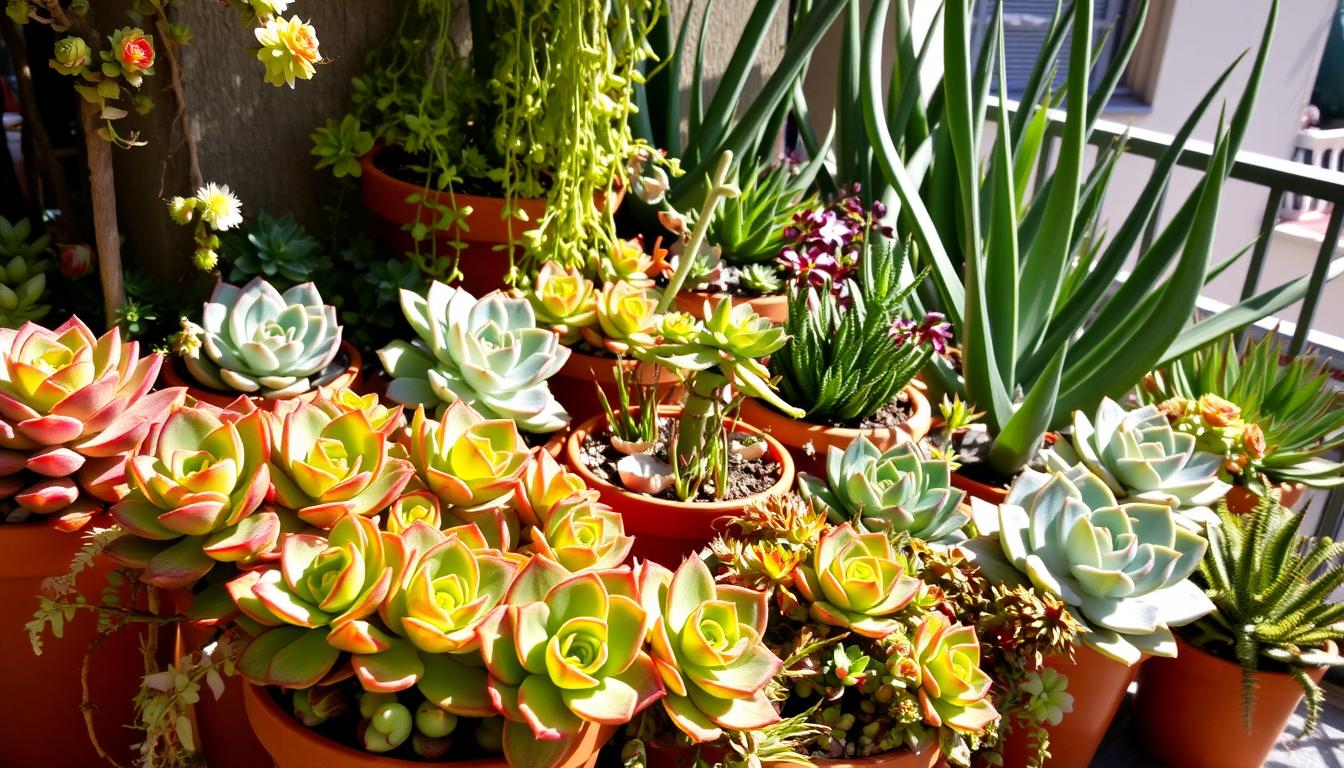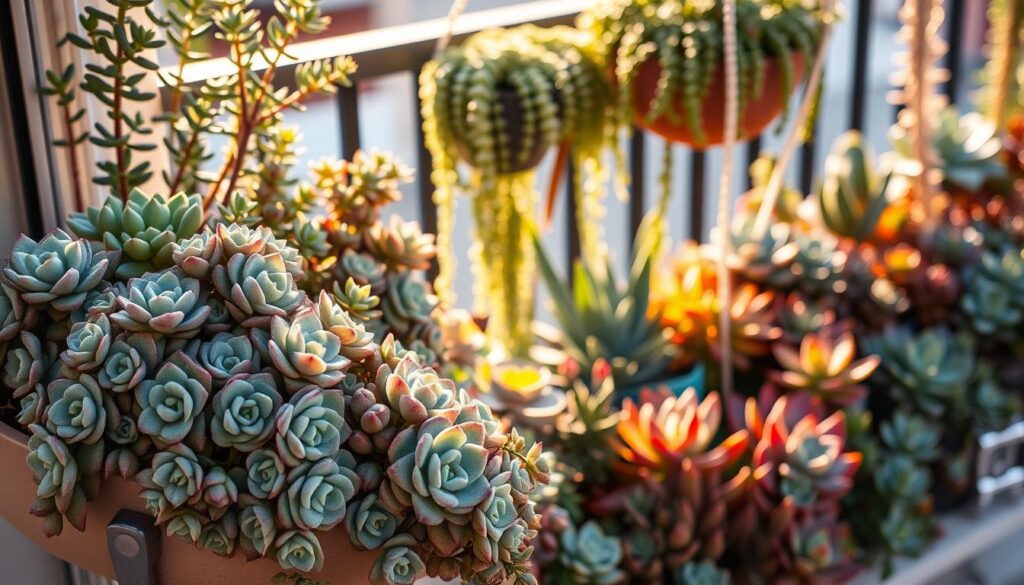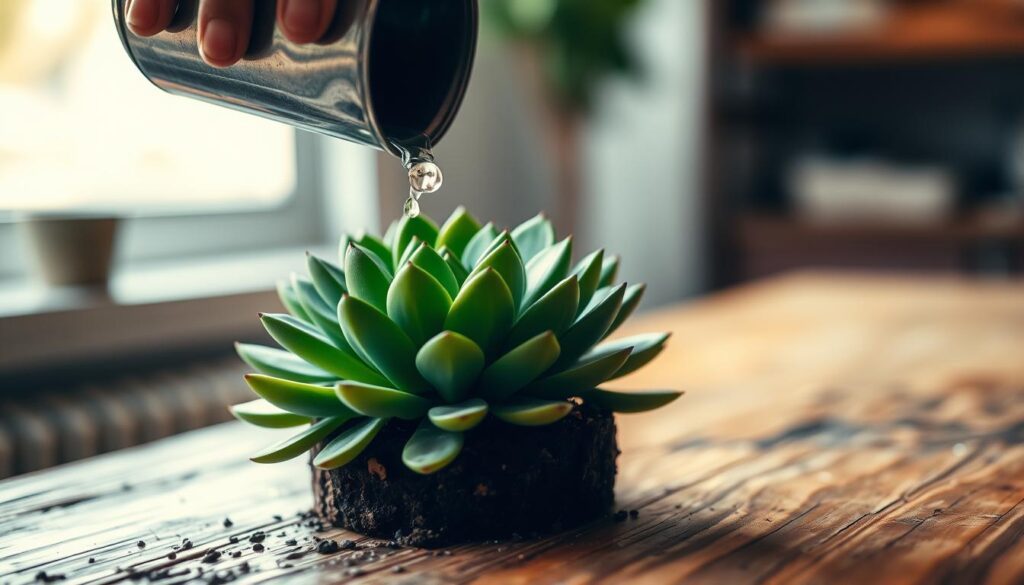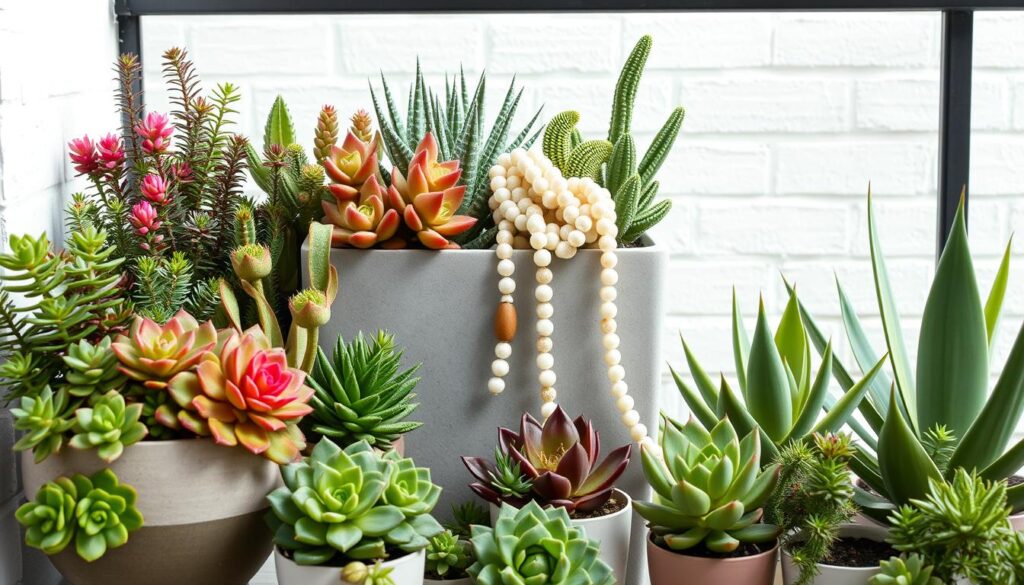
The No-Fail Guide to Growing Succulents on Your Balcony
Are you tired of watching your balcony garden struggle? Can you really grow beautiful plants in a challenging outdoor space? Yes, you can, with the right guidance, create a stunning oasis.
Growing succulent plants on your balcony adds greenery to your space. These plants are low-maintenance, perfect for busy people or gardening newbies.
With proper succulent care, your balcony garden can thrive with little upkeep. This guide will show you how to create a beautiful, resilient outdoor space.
Why Choose Succulents for Your Balcony Garden?
Succulents are a great choice for balcony gardens. They are perfect for small spaces and changing weather. Their special traits help them thrive in these conditions.
The Benefits of Succulents
Succulents have many benefits. They can survive with little water, which is great for those who forget to water. They also clean the air, making spaces healthier.
There are many succulent varieties to choose from. This lets gardeners create unique and colorful arrangements. It’s a fun way to show off your style.
| Benefit | Description | Advantage |
|---|---|---|
| Drought Tolerance | Ability to survive with minimal watering | Ideal for busy individuals or forgetful gardeners |
| Air Purification | Capacity to remove pollutants from the air | Contributes to a healthier environment |
| Variety | Diverse range of shapes, sizes, and colors | Allows for creative and personalized garden designs |
Aesthetic Appeal
Succulents are known for their beauty. They come in many shapes and colors, adding to any garden. They can make your space look better, whether it’s simple or full of life.
Low Maintenance Requirements
Succulents are easy to take care of. They need less water and pruning than other plants. This makes them perfect for beginners or those with little time to garden.
Understanding Different Types of Succulents
Choosing the right succulents for your balcony can be exciting and a bit overwhelming. There are hundreds of types, each with its own look and feel. This variety lets you create a unique and eye-catching garden.
Succulents aren’t just one or two types. There are many species, each with its own needs and looks. Knowing these differences helps you pick the best succulents for your balcony.
Popular Varieties for Beginners
For beginners, starting with easy-to-grow succulents is a good idea. Aloe Vera, Echeveria, and Crassula (Jade Plant) are great choices. They’re hardy and can grow well in different conditions.
Aloe Vera is not only popular but also has health benefits. Echeveria is loved for its beautiful rosettes. Crassula is easy to care for and can handle some neglect.
Unique Succulent Species to Consider
Once you’re comfortable with the basics, you can explore unique succulents. Lithops (Living Stones), Conophytum, and Haworthia are great examples. They have interesting shapes and growth patterns that can make your garden stand out.
| Succulent Type | Description | Care Level |
|---|---|---|
| Aloe Vera | Medicinal properties, thick fleshy leaves | Easy |
| Echeveria | Beautiful rosettes, variety of colors | Moderate |
| Lithops | Mimics stones, unique appearance | Challenging |
Seasonal Succulent Options
Some succulents are better suited for certain seasons. For winter, choose cold-hardy succulents like Sempervivum (Hens and Chicks). In summer, Agave and Euphorbia do well in the heat.
Knowing what succulents need in different seasons helps your garden stay vibrant all year.
Essential Supplies for Growing Succulents
To grow thriving outdoor succulents, start with the right supplies. The correct equipment makes succulent care easier. It also boosts your plants’ chances of thriving.
Starting a beautiful succulent garden requires understanding their basic needs. Succulents need specific conditions to grow well. The right supplies help create an ideal environment.
Selecting the Right Pots and Containers
Choosing the right pots and containers is the first step. Succulents need good drainage to prevent root rot. Look for pots with drainage holes.
Choose a pot that’s slightly larger than the succulent’s root system. This allows the roots to grow without getting too wet. You can use creative containers like old boots or wooden crates, as long as they have drainage holes.
Ideal Soil for Succulents
The soil is crucial for succulent care. Succulents do well in well-draining soil that prevents water from pooling around the roots. You can buy a pre-made mix or make your own with perlite, sand, or small rocks.
A good succulent soil mix should hold some moisture but drain excess water fast. This balance is key to keeping your succulents healthy, avoiding both drought and waterlogging.
Tools for Planting and Care
Having the right tools makes succulent care easier. You’ll need a watering can with a long spout, a trowel or small shovel, and gloves to protect your hands from thorns.
A spray bottle is useful for misting your succulents in hot weather. For more advanced care, consider a soil moisture meter to check soil moisture accurately.
Choosing the Perfect Location on Your Balcony
Finding the right spot for your balcony succulent garden is key. Succulents can grow well in different places, but where you put them matters a lot.
Sunlight Needs of Succulents
Succulents need sunlight to grow. Think about how much sun your balcony gets. South-facing balconies are great for plants that love full sun. East- or west-facing balconies are better for those that like partial shade.
Know what your succulents need in terms of sunlight. Some can handle full sun, while others need shade to avoid burning.

Wind and Rain Considerations
Wind and rain are important when picking a spot for your succulents. Strong winds can hurt the plants, and too much rain can cause root rot.
If your balcony gets a lot of wind, think about using a windscreen. Or move the succulents to a safer spot when it’s really windy.
Indoor vs. Outdoor Placement
Deciding where to put your succulents depends on your balcony and what you like. Putting them outside is best if they need lots of sunlight and air.
But if your balcony has extreme weather, indoors might be better. Make sure the indoor spot gets enough light, either from the sun or extra lights.
Planting Succulents: A Step-by-Step Guide
Planting succulents is more than just putting them in a pot. It’s about creating a caring space for them to grow. This way, you can enjoy their beauty for many years.
Preparing the Soil and Containers
The first step is to prepare the soil and pick the right containers. Succulents need soil that drains well to avoid root rot. You can buy a mix or make your own with potting soil, perlite, and sand.
Choosing the right container is also key. Succulents need pots with holes to prevent waterlogged soil. Terracotta pots are great because they let moisture evaporate fast.
Planting Techniques for Different Species
Each succulent type has its own planting needs. For example, Echeveria and Crassula can be planted with leaf cuttings. But Aloe vera prefers offsets or division.
When planting, carefully remove the succulent from its pot. Be gentle with the roots. If the roots are tight, loosen them with your fingers. Put the succulent in the new pot and add fresh soil, leaving the leaves uncovered.
For moisture-sensitive succulents like some Haworthia species, let the cut ends dry for a few days. This helps prevent rot.
Watering Your Succulents: The Essentials
Proper watering is key for outdoor succulents to thrive. It’s a crucial part of succulent care. Getting it right can make a big difference in your plant’s health.
Learning to water your succulents well is more than just knowing when. It’s about understanding your plants’ needs and adjusting your care.
How Often Should You Water?
How often to water succulents depends on several things. These include the climate, soil mix, and the time of year. Generally, outdoor succulents need more water in warmer months when they grow fast.
In spring and summer, watering once a week is usually enough. But weather can change this. In very hot, dry places, you might need to water more often.

Recognizing Overwatering vs. Underwatering
Many succulent owners struggle with overwatering. Signs include soft, mushy stems and leaves. Underwatering shows as shriveled, dry leaves.
To avoid these problems, watch your plants closely. Adjust your watering based on their needs. Check soil moisture by feeling it with your finger up to the first knuckle.
Seasonal Watering Adjustments
Watering needs change with the seasons. In fall and winter, succulents need less water because they’re dormant.
Watering less during these months helps prevent root rot and other issues. Watering once every 4-6 weeks is usually enough in cooler months.
Adjusting your watering to fit the seasons helps your succulents stay healthy and thrive.
Fertilizing Succulents for Optimal Growth
To keep your succulent plants thriving, it’s key to know how to fertilize them right. Fertilization gives them the nutrients they need to grow strong and stay colorful.
Succulent varieties need different nutrients, but most do well with balanced cacti and succulent fertilizers. The right fertilizer boosts root and leaf growth, improving overall health.
Types of Fertilizers to Use
Choosing the right fertilizer is crucial for succulent growth. There are several options:
1. Balanced, water-soluble fertilizers are a favorite. They’re simple to use and can be adjusted as needed.
2. Slow-release fertilizers give nutrients over time, so you don’t have to fertilize as often.
3. Organic fertilizers, like compost or worm casting, are a natural and eco-friendly choice for succulents.
When and How to Fertilize
Fertilizing succulents needs to be done at the right time and in the right amount. Spring and summer are the best times to fertilize, as these are when they grow the most.
1. Dilute the fertilizer to half the recommended strength to prevent root burn.
2. Apply fertilizer sparingly, as succulents are used to growing in poor soil.
3. Avoid fertilizing in the dormant season (fall and winter) when they need less nutrients.
By knowing what your succulents need and how to fertilize them, you can help them grow well. This way, you can enjoy their unique beauty.
Common Pests and Problems with Succulents
Succulents are tough, but they can still face pests and problems. Knowing these issues is key for succulent care and keeping your plants healthy.
Identifying Common Pests
Several pests can harm succulents, like mealybugs, spider mites, and scale. Mealybugs look like white, cottony patches on leaves. Spider mites cause yellow spots or stippling. Scale insects are small, immobile bumps on stems and leaves.

Solutions for Pest Control
To fight pests, isolate affected plants to stop the spread. For mealybugs and scale, use a cotton swab with alcohol. Spider mites can be managed with water spray or insecticidal soap. Regular checks help catch problems early.
For big infestations, neem oil or systemic insecticides might be needed. Always read the labels and protect your plants.
Dealing with Fungal Issues
Fungal diseases are common in succulents, often from too much water. Root rot is a big problem, where roots turn soft and mushy. To avoid this, ensure good air flow and don’t water leaves.
If you see fungal signs like soft, black roots or leaves, repot in dry soil. Cut off any bad roots or leaves to stop the disease. Sometimes, fungicides are needed, but use them carefully.
Propagating Succulents: Easy Methods
Growing succulents is fun because they’re easy to multiply. You can grow more plants for yourself or share them with friends. Learning how to propagate succulents is rewarding and simple.
Leaf Cuttings
Leaf cuttings are a common way to grow new succulents. First, pick healthy leaves from your plant. Look for leaves that are firm and not damaged. Twist or cut the leaves from the stem and let them dry for a few days.
This drying step is key to prevent rotting when planted. After drying, plant the leaves in soil that drains well. Keep the soil moist until roots grow.
Offsets and Division
Many succulents grow offsets or “pups” at the base. These can be removed when they’re big enough. Wait until they’re about one-third to one-half the size of the mother plant.
When removing, be gentle with the roots. Let the offset dry for a day or two before planting it in new soil.
Division is for succulents that have outgrown their pots. Remove the plant, separate the roots, and replant the sections in new pots. Use fresh, well-draining soil.
Water Propagation Techniques
Water propagation roots succulent cuttings or leaves in water. It works well for some succulent types. Place the cut end of a leaf or stem in water, making sure the water level is below the node.
Roots will grow in a few weeks. Once strong, move the plant to soil.
Learning these easy propagation methods lets you grow a big collection of indoor succulents. You can also share your plants with others.
DIY Balcony Decor with Succulents
With a little creativity, your balcony can become a stunning succulent garden. Succulents offer a wide range of possibilities for decorative arrangements. They can enhance the aesthetic appeal of your outdoor space.
Creating Beautiful Arrangements is a great way to start your succulent balcony decor. You can combine different species of succulents in a single container. This creates a visually appealing display.
Consider mixing succulents with varying textures, colors, and shapes. This adds depth and interest to your arrangements.
Creating Beautiful Arrangements
When creating succulent arrangements, choose plants that have similar lighting and watering needs. This ensures that all the plants in your arrangement thrive. You can also add decorative elements like rocks, pebbles, or seashells to enhance the visual appeal.
Tips for a stunning arrangement: Use a variety of succulent sizes and shapes. Incorporate plants with different growth habits, like trailing or upright succulents. Don’t overcrowd the container; leave enough space for proper growth.
Using Succulents in Vertical Gardens
Vertical gardens are a fantastic way to maximize space on your balcony. Succulents are ideal for vertical gardens because they are low maintenance. They can thrive in a variety of conditions.
You can use a trellis, a wall-mounted planter, or a pocket planter to create a succulent vertical garden.

Benefits of vertical succulent gardens: They add a unique decorative element to your balcony. They can help to purify the air and improve the ambiance. They are relatively easy to maintain, as long as you ensure proper watering and sunlight.
Incorporating Other Plants for Variety
While succulents are stunning on their own, incorporating other plants can add variety and texture to your balcony garden. Consider mixing succulents with other low-maintenance plants like herbs, ferns, or flowering plants that have similar care requirements.
Combining plants effectively: Choose plants with complementary growth habits and care needs. Ensure that the plants you choose can thrive in the same lighting conditions. Experiment with different combinations to find what works best for your balcony.
Seasonal Care Tips for Your Succulents
As seasons change, your succulents need different care to grow well on your balcony. It’s important to understand and adjust to these needs. This keeps your succulent garden healthy and lively.
Summer Care Practices
In summer, succulents grow a lot. They need more water because it’s hot. But, don’t water too much. Water your succulents in the morning or early evening to keep the soil moist.
Summer is also a great time to fertilize your succulents. Use a balanced, water-soluble fertilizer. This helps them grow strong and handle the heat better.
Winterizing Your Balcony Garden
In winter, succulents slow down and need less care. Water them once a month or less, depending on your balcony’s humidity and temperature.
Keep your succulents safe from frost. Bring them inside or cover them with a frost blanket. Some succulents are more sensitive to cold than others. So, learn what your plants need.
Adapting to Changing Weather Conditions
Weather can be unpredictable. Being ready is key to a healthy succulent garden. Watch the weather forecast for extreme weather like heavy rain or intense heat.
Use protective measures like moving pots to safe spots or using shade cloth. This protects your succulents from harsh weather.
By following these seasonal care tips, your succulents will stay healthy and thrive all year. Good succulent care means paying attention to your plants’ changing needs with the seasons.
Joining the Succulent Community
As you grow and care for your succulents, you’ll want to meet others who love them too. Joining a community of succulent fans can help you learn new things. You’ll also get to show off your beautiful plants.
Local Clubs and Groups
Search for local succulent clubs or groups in your area. They often have meetings, workshops, and events. These are great chances to meet others, swap plants, and learn from experts.
Online Forums and Resources
Online forums and social media are also great places to connect. Sites like Instagram and Facebook have groups for succulent lovers. Here, you can share photos, ask questions, and learn from others.
Sharing Your Succulent Journey
Think about sharing your succulent journey on social media. It can inspire others and get you feedback on your plants. Use hashtags and tag succulent accounts to reach more people and stay up-to-date with new varieties.
Leave a Reply